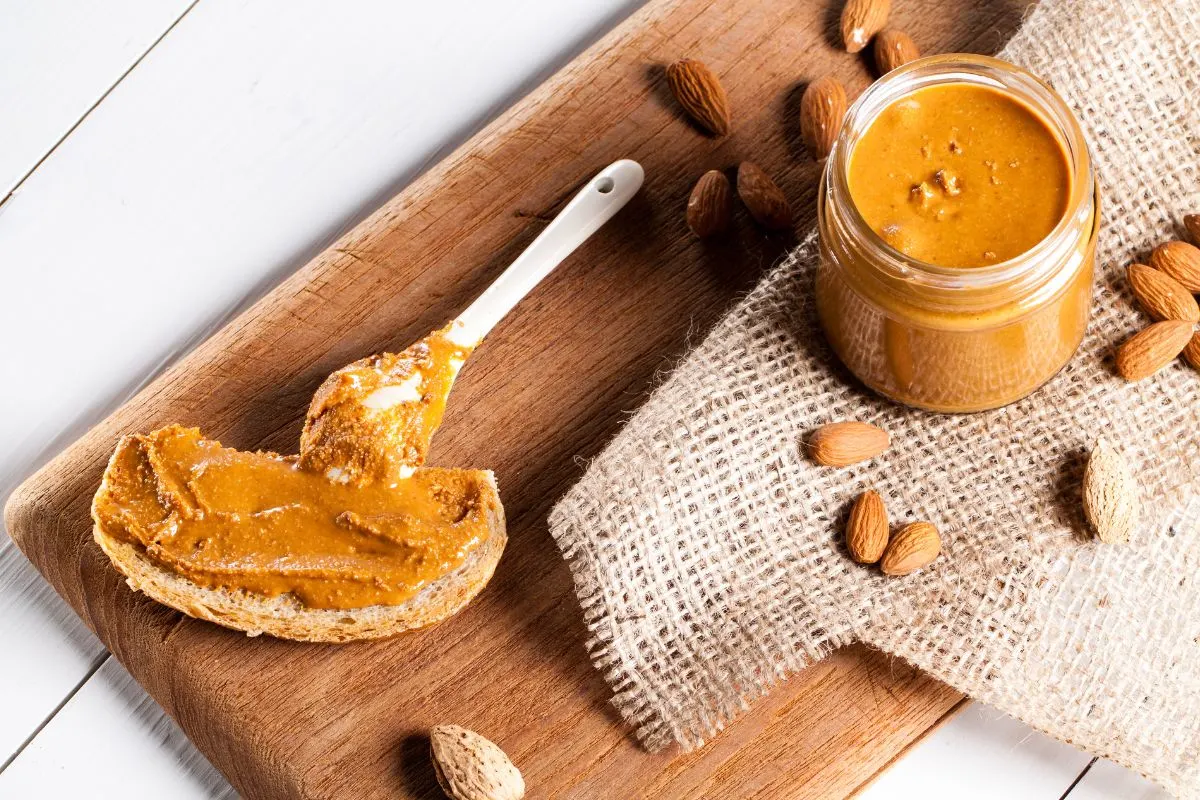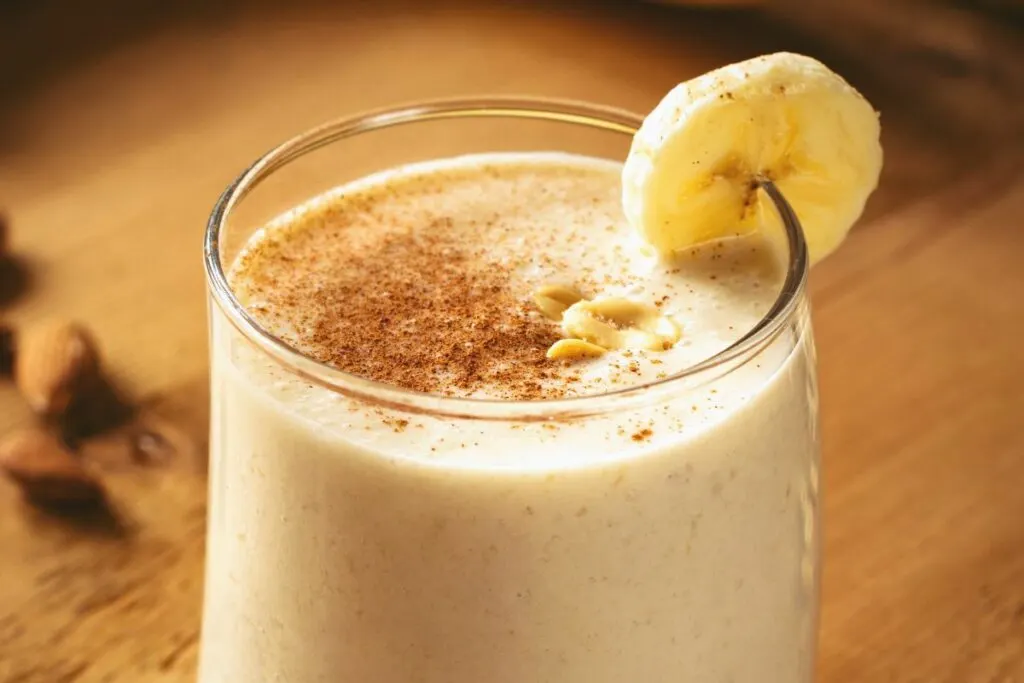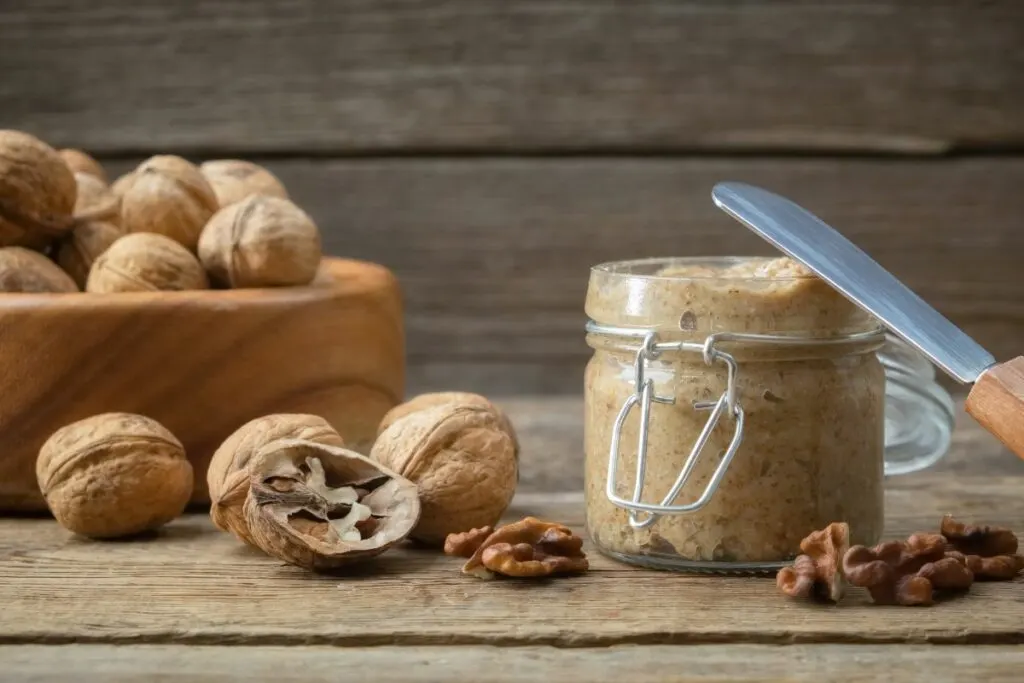Almond butter is one of the healthiest foods on the planet. It has a delicious, thick consistency and nutty taste that’s used in some Asian sauces. Yet around 1% of the general population is allergic to tree nuts, leading many to look for some almond butter substitutes. Luckily for you, I’ve got the best.
You can substitute almond butter with peanut butter, cashew butter, hazelnut butter, and coconut butter. But this isn’t all! There are several more substitutes for almond butter I’ll cover, so let’s hop in!

Jump To
🤷 What is Almond Butter?
Almond butter is a nut butter made from ground almonds. It has a notably earthy and nutty flavor, with salt enhancing the naturally sweet, earthy flavor of the almonds. Added sweeteners vary from sugars to more natural sweeteners such as agave nectar substitutes, coconut sugar, maple syrup alternatives, and honey alternatives.
🆚 Almond butter vs peanut butter
Almond butter and peanut butter are both popular nut butters, but they have some differences in flavor and nutrition. Almond butter has a slightly sweeter and nuttier flavor than peanut butter, and it’s higher in vitamin E, magnesium, and fiber. Peanut butter, on the other hand, is higher in protein and folate.
🧑🍳 How to Make Almond Butter
To make almond butter, start by roasting 2 cups of raw almonds in a preheated oven at 350°F (175°C) for 10-12 minutes until they become fragrant. Allow them to cool slightly before placing them in a food processor. Process the almonds, occasionally scraping down the sides, until a thick and creamy consistency is achieved. This process may take about 10-15 minutes, depending on the desired smoothness.
🧑⚕️ Nutritional Benefits of Almond Butter
Nutritional Benefits:
- Good source of magnesium, potassium, selenium, and vitamin E.
- Rich in dietary fiber, protein, heart-healthy nutrients, and unsaturated fats, increasing satiety.
- Low glycemic index, preventing blood sugar spikes and potentially lowering the risk of diabetes.
Health Benefits:
- Abundant plant-based protein enhances brain function and promotes healthy skin.
- Consumption in moderation provides wholesome nutrients.

📌 How to Use Almond Butter
Here are some ways you can add the almond butter substitutes to your diet:
- Almond Butter & Honey Sandwich
- Banana Almond Butter Smoothie
- Pancakes, Waffles, and French toast topping
- Chocolate Chip Almond Butter Cookies
- Stirred with Granola
- Fresh Vegetable Spring Rolls with Almond Butter dipping sauce
- Asian Salad Dressing
- Chicken or Vegetable Curries
- Kare-Kare (Ox-tail and tripe stew in almond butter sauce)
- Almond Butter Cups
- Peanut-Free Pad Thai
💡 9 Best Almond Butter Substitutes
Peanut Butter
The easiest swap for almond butter is probably already in your pantry, peanut butter. Almond butter and peanut butter are nutty butters that go hand-in-hand with almost the same nutritional value, texture, and similar flavors, so they pretty much have the same uses. You can use it at a 1:1 ratio for cooking and baking applications.
Homemade Almond Butter
If you have the time to whip out your apron, then try whipping up your own almond butter at home. Here’s a great recipe from The Big Man’s World that only has one ingredient – raw, unsalted almonds. It’s inexpensive and easy to make, and all you need is to source good, organic almonds. The beauty of making your own is that you know exactly what goes into your nut butter. You can use this in any of your recipes that call for almond butter in a 1:1 ratio.

Cashew Butter
Cashew butter has a surprisingly mild, sweet, nutty flavor that’s usually made from roasted cashews. Cashews are an excellent snack on their own. They also boast healthy monounsaturated fatty acids, essential amino acids, and magnesium. Some cashew butter even has a similar texture to your favorite almond butter. Just swap cashew butter for almond butter at a 1:1 ratio in most recipes that call for almond butter.
Hazelnut Butter
Like almond butter, hazelnut butter is made from roasted hazelnuts. It’s notoriously paired with sugar & chocolate flavoring to create the widely popular Nutella spread. This swap should be reserved for desserts and other sweeter recipes. You can make your own and roast, process, and flavor the hazelnut butter according to your own tastes and preferences. Hazelnut butter should be used in a 1:1 ratio.
Tahini
If you’re looking for a nut-free option, tahini is a great alternative to almond butter. It’s safe for people with nut allergies, as it’s made from hulled, roasted sesame seeds and is full of nutrients and antioxidants. When used on its own, it tastes like smoky peanut butter, so many people offset it with sweeteners or toppings, like in my tahini brussels sprouts. You can use a 1:1 swap ratio for sauces, soups, salad dressings, or stews.
Walnut Butter
Like the other tree nut butter on this list, walnut butter is a good source of heart-healthy fats, fiber, and antioxidants. Walnuts are the oldest tree food known to mankind, dating back to as early as 7,000 B.C. They are particularly favored for their fairly mild, earthy flavor with a tangy undertone. These flavors lend themselves to walnut butter, making for a good 1:1 swap ratio for almond butter.

Sunflower Seed Butter
Sunflower butter, also known as sunflower seed butter or sun butter, is a tree nut-free substitute for almond butter. If you have a Mugwort pollen allergy, you should avoid it. Similar to tahini, this product is a seed paste made from roasted, ground sunflower seeds. A tablespoon of this seed butter supplies the body with just under half the daily requirement for vitamin E and is a great source of protein, healthy fats, and magnesium. A 1:1 swap ratio is perfect for dressings and low histamine sauces.
Coconut Butter
Coconut butter is a divine spread made from grinding raw coconut meat into a smooth consistency. This creamy vegan butter is another nut-free alternative to almond butter. Its distinct taste comes from the coconut fruit, which is a bit sweet and slightly nutty. It also has a gritty consistency that becomes runny when warmed and solid when cool. Like almond butter, you can add coconut butter to baked goods, smoothies, sandwiches, and fruits in a 1:1 swap.
Powdered Peanut Butter
Powdered peanut butter is made from roasted peanuts that have been pressed to remove most of the fat. With most of the fat removed, this makes for a fantastic low-fat, low-calorie (about 75% fewer calories than peanut butter) alternative to nut butter. It’s a good source of protein and fiber, minus heart-healthy fats. Make sure to check whether you have sweetened or unsweetened peanut butter powder and use it in a 1:1 ratio.
🧐 FAQs
You can try using sunflower seed butter or pumpkin seed butter. Both of these options have a similar consistency to almond butter and can be used in recipes like smoothies, sauces, and baked goods.
Almond butter has a nutty and creamy flavor that’s similar to peanut butter but with a slightly sweeter taste. Some almond butter brands even add salt, sugar, or other ingredients to enhance the flavor.
An applesauce substitute can be used as a healthy alternative to almond butter in some recipes, but it won’t work well in all recipes. Applesauce has a different consistency than almond butter, so it may not work well in recipes that rely on the thickness and creaminess of almond butter.
